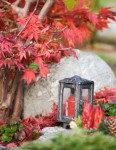What is Natural Burial?
 In an age when green funerals and funeral planning on a budget are on everyone’s lips, people are beginning to question the need for so many different containers and preparations for the disposal of a body. We researched into why natural burial, a solution in which very few preparations are made and the body is laid to rest directly within the soil of the earth, is one of the most common answers.
In an age when green funerals and funeral planning on a budget are on everyone’s lips, people are beginning to question the need for so many different containers and preparations for the disposal of a body. We researched into why natural burial, a solution in which very few preparations are made and the body is laid to rest directly within the soil of the earth, is one of the most common answers.
How Burial Works
Traditionally, the body of a loved one is embalmed before being placed in a casket, which is then lowered into a grave that contains a grave liner or vault. These various “layers” between the body of the deceased and the ground cannot stop the natural process of decomposition, but they do slow it down and also provide some comfort to families who wish to preserve their memories of the deceased.
While there is nothing wrong with traditional burial, so many people being buried each year can put a strain on the earth’s resources. Every year, the funeral industry buries over 100,000 tons of steel, a million tons of concrete, and 30 million feet of hardwood. Embalming fluid, which can contain carcinogens, also tallies in at over 800,000 gallons per year.
The Natural Burial Alternative
In natural burial, the body is interred directly into the soil, allowing it to decompose faster and without fanfare. This doesn’t mean a body is dumped into a hole or otherwise disrespected—it merely means that several steps are skipped to reduce the amount of resources put into the process. For example:
- The body may or may not be embalmed. Some people opt for this step so they can have a traditional viewing in a rented casket—others prefer to keep things simple. The choice is yours.
- The body is placed in some sort of liner. This can be a biodegradable coffin (often made of wicker or cardboard), a traditional casket, a homemade casket, or a burial shroud (which is common in many religions). Vault liners, which are large, typically concrete structures that help prevent the ground from sinking, are not used.
- Large, ornate headstones typically aren’t used. A small, flat marker or other personalized memento marks the grave in a way that doesn’t put a further burden on the earth’s resources. Living memorials like trees, rose bushes, or other garden items are common.
Where Can I Find Natural Burial Options?
Natural burial is still a new enough process that you can’t find it everywhere. There are rules in every state that restrict where and how you bury people on private land, and many cemeteries have regulations against natural burial since they require vault liners for aesthetic purposes.
In most cases, you’ll need to find a special cemetery or natural burial facility that promotes this practice. Look for funeral organizations that offer green cemeteries, natural cemeteries, burial grounds, land trusts, nature preserves, or nature centers, as these are the terms most often used to designate areas where natural burials occur.



